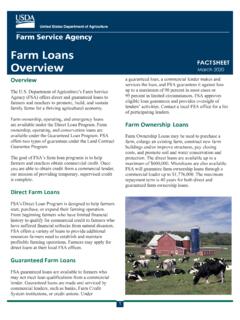Transcription of Design Standards No. 13 Embankment Dams
1 Design Standards No. 13 Embankment Dams Chapter 2: Embankment Design Phase 4 (Final) Department of the InteriorBureau of Reclamation December 2012 Mission Statements The Department of the Interior protects America's natural resources and heritage, honors our cultures and tribal communities, and supplies the energy to power our future. The mission of the Bureau of Reclamation is to manage, develop, and protect water and related resources in an environmentally and economically sound manner in the interest of the American public.
2 Design Standards Signature Sheet Design Standards No. 13 Embankment Dams DS-13(2)-10: Phase 4 (Final) December 2012 Chapter 2: Embankment Design Chapter Signature Sheet Bureau of Reclamation Technical Service Center Design Standards No. 13 Embankment Dams Chapter 2: Embankment Design DS-13(2)-10:1 Phase 4 (Final) Chapter 2 Embankment Design is an existing chapter (last revised June 1992) within Design Standards No. 13 and was revised as follows: Minor revisions to reflect current terminology Minor revisions to reflect latest state-of-practice Added photographs and drawings 1 DS-13(2)-10 refers to Design Standard No.
3 13, chapter 2, revision 10. vo l DateDate Date V2/ te 512_0/I 4 Date ,Atkog. Date Prepared by: William . Engemoen, Civil En neer, Geotechnical Services Division Peer Review: Allen H. Kiene, Civil Engineer, Geotechnical Engineering Group 2 Security Review: Robert L. Dewey, Civil Engineer, Geotechnical Engineering Group 3 Reco mended for Technical Approval: Thomas McDaniel, Geotechnical Engineer, Geotechnical Engineering Group 2 Submitted: Kart Knight, Chief, Geotechnical Services Division Approved: Lowell Pimley, Director, Technical Service Center Design Standards No.
4 13, Chapter 2 Contents Page 2-1 2-1 2-1 Deviations from Standard .. 2-1 Revisions of Standard .. 2-1 Applicability .. 2-1 Earthfill Dams .. 2-2 Origin and Development .. 2-2 General Comments on Earthfill Dams .. 2-3 Selection and Types of Earthfill Dams .. 2-3 Design 2-7 Criteria for Design .. 2-8 General Construction Methods .. 2-10 Foundation Design for Earthfill 2-10 General.
5 2-10 Rock Foundations .. 2-11 Sand and Gravel Foundations .. 2-15 Silt and Clay Foundations .. 2-19 Embankment Design for Earthfill Dams .. 2-22 Static Stability .. 2-22 Seepage and Leakage through Embankments .. 2-23 Utilization of Materials from Required 2-29 Zoning .. 2-32 Seismic 2-37 Security Considerations .. 2-37 Embankment Details for Earthfill Dams .. 2-38 Crest 2-38 Freeboard.
6 2-42 Upstream Slope Protection .. 2-44 Downstream Slope 2-48 Surface 2-50 Flared Slopes at Abutments .. 2-51 Typical Maximum Sections .. 2-52 Rockfill Dams .. 2-52 Origin and Usage .. 2-52 Definition and Types of Rockfill Dams .. 2-53 Impervious Elements Other than Clay Cores .. 2-56 Foundation Design for Rockfill Dams .. 2-57 Foundation Requirements and Treatment .. 2-57 Membrane Cutoffs .. 2-58 DS-13(2)-10 December 2012 2-i Contents (continued) Page Embankment Design for Rockfill Dams.
7 2-61 Selection of Rock 2-61 Embankment Sections for Rockfill Dams .. 2-66 Stability .. 2-70 Placement of Rockfill Materials .. 2-70 Compaction .. 2-71 Membrane Design for Rockfill Dams .. 2-72 Impervious 2-72 Reinforced Concrete .. 2-73 Asphaltic 2-76 Steel Facings .. 2-82 Timber 2-84 Geomembranes .. 2-84 Evaluating and Modifying Existing Embankment Dams .. 2-84 2-85 Figures Figure Page Effects of drainage.
8 2-5 Types of earthfill dams.. 2-9 Examples of filters around penetrating conduits: (a) typical filter addition around a conduit near the centerline of a dam, and (b) typical filter addition around a conduit near the downstream toe of a dam .. 2-27 Recommended Design and compaction details for penetrating 2-29 Use of random fill materials within an Embankment .. 2-31 Example materials distribution chart.. 2-33 Crest and camber details - Jordanelle Dam, Utah.. 2-40 Examples of crest details at maximum camber.
9 2-43 Riprap on upstream slope of Horsetooth Dam, Colorado .. 2-45 Soil-cement slope protection at Choke Canyon Dam, Texas.. 2-46 Placement of soil-cement slope protection, Starvation Dam, Utah.. 2-47 Placement of soil-cement on the interior Embankment slopes of Warren H. Brock Reservoir, California, using the plating method of placement.. 2-48 Cobble slope protection on downstream slope of Jordanelle Dam, Utah.
10 2-49 DS-13(2)-10 December 2012 2-ii Figures (continued) Figure Vegetated slope protection on downstream slope of Scoggins Dam, Oregon.. 2-49 Contour ditch at Belle Fourche Dam, South Dakota.











